+ データを開く
データを開く
- 基本情報
基本情報
| 登録情報 | データベース: PDB / ID: 6p07 | |||||||||
|---|---|---|---|---|---|---|---|---|---|---|
| タイトル | Spastin hexamer in complex with substrate | |||||||||
 要素 要素 |
| |||||||||
 キーワード キーワード | MOTOR PROTEIN / AAA+ ATPase / Homohexamer / Microtubule Severing Enzyme | |||||||||
| 機能・相同性 |  機能・相同性情報 機能・相同性情報microtubule-severing ATPase / microtubule severing ATPase activity / mitotic chromosome movement towards spindle pole / microtubule severing / positive regulation of microtubule depolymerization / mitotic spindle elongation / protein hexamerization / regulation of synapse structure or activity / isomerase activity / lipid droplet ...microtubule-severing ATPase / microtubule severing ATPase activity / mitotic chromosome movement towards spindle pole / microtubule severing / positive regulation of microtubule depolymerization / mitotic spindle elongation / protein hexamerization / regulation of synapse structure or activity / isomerase activity / lipid droplet / adult locomotory behavior / spindle / nervous system development / chromosome / microtubule binding / microtubule / cell differentiation / cell division / centrosome / ATP hydrolysis activity / ATP binding / identical protein binding / membrane / cytoplasm 類似検索 - 分子機能 | |||||||||
| 生物種 |  | |||||||||
| 手法 | 電子顕微鏡法 / 単粒子再構成法 / クライオ電子顕微鏡法 / 解像度: 3.2 Å | |||||||||
 データ登録者 データ登録者 | Sandate, C.R. / Szyk, A. / Zehr, E. / Roll-Mecak, A. / Lander, G.C. | |||||||||
| 資金援助 |  米国, 2件 米国, 2件
| |||||||||
 引用 引用 |  ジャーナル: Nat Struct Mol Biol / 年: 2019 ジャーナル: Nat Struct Mol Biol / 年: 2019タイトル: An allosteric network in spastin couples multiple activities required for microtubule severing. 著者: Colby R Sandate / Agnieszka Szyk / Elena A Zehr / Gabriel C Lander / Antonina Roll-Mecak /  要旨: The AAA+ ATPase spastin remodels microtubule arrays through severing and its mutation is the most common cause of hereditary spastic paraplegias (HSP). Polyglutamylation of the tubulin C-terminal ...The AAA+ ATPase spastin remodels microtubule arrays through severing and its mutation is the most common cause of hereditary spastic paraplegias (HSP). Polyglutamylation of the tubulin C-terminal tail recruits spastin to microtubules and modulates severing activity. Here, we present a ~3.2 Å resolution cryo-EM structure of the Drosophila melanogaster spastin hexamer with a polyglutamate peptide bound in its central pore. Two electropositive loops arranged in a double-helical staircase coordinate the substrate sidechains. The structure reveals how concurrent nucleotide and substrate binding organizes the conserved spastin pore loops into an ordered network that is allosterically coupled to oligomerization, and suggests how tubulin tail engagement activates spastin for microtubule disassembly. This allosteric coupling may apply generally in organizing AAA+ protein translocases into their active conformations. We show that this allosteric network is essential for severing and is a hotspot for HSP mutations. | |||||||||
| 履歴 |
|
- 構造の表示
構造の表示
| ムービー |
 ムービービューア ムービービューア |
|---|---|
| 構造ビューア | 分子:  Molmil Molmil Jmol/JSmol Jmol/JSmol |
- ダウンロードとリンク
ダウンロードとリンク
- ダウンロード
ダウンロード
| PDBx/mmCIF形式 |  6p07.cif.gz 6p07.cif.gz | 329 KB | 表示 |  PDBx/mmCIF形式 PDBx/mmCIF形式 |
|---|---|---|---|---|
| PDB形式 |  pdb6p07.ent.gz pdb6p07.ent.gz | 261.3 KB | 表示 |  PDB形式 PDB形式 |
| PDBx/mmJSON形式 |  6p07.json.gz 6p07.json.gz | ツリー表示 |  PDBx/mmJSON形式 PDBx/mmJSON形式 | |
| その他 |  その他のダウンロード その他のダウンロード |
-検証レポート
| 文書・要旨 |  6p07_validation.pdf.gz 6p07_validation.pdf.gz | 1.6 MB | 表示 |  wwPDB検証レポート wwPDB検証レポート |
|---|---|---|---|---|
| 文書・詳細版 |  6p07_full_validation.pdf.gz 6p07_full_validation.pdf.gz | 1.6 MB | 表示 | |
| XML形式データ |  6p07_validation.xml.gz 6p07_validation.xml.gz | 61.4 KB | 表示 | |
| CIF形式データ |  6p07_validation.cif.gz 6p07_validation.cif.gz | 90.1 KB | 表示 | |
| アーカイブディレクトリ |  https://data.pdbj.org/pub/pdb/validation_reports/p0/6p07 https://data.pdbj.org/pub/pdb/validation_reports/p0/6p07 ftp://data.pdbj.org/pub/pdb/validation_reports/p0/6p07 ftp://data.pdbj.org/pub/pdb/validation_reports/p0/6p07 | HTTPS FTP |
-関連構造データ
- リンク
リンク
- 集合体
集合体
| 登録構造単位 | 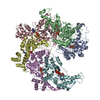
|
|---|---|
| 1 |
|
- 要素
要素
| #1: タンパク質 | 分子量: 54183.473 Da / 分子数: 6 / 変異: E583Q / 由来タイプ: 組換発現 由来: (組換発現)  遺伝子: spas, D-spastin, Dmel\CG5977, Dspastin, Spas, Spastin, CG5977, Dmel_CG5977 発現宿主:  参照: UniProt: A0A126GV13, UniProt: A0A0B4LHJ5*PLUS, microtubule-severing ATPase #2: タンパク質・ペプチド | | 分子量: 1954.722 Da / 分子数: 1 / 由来タイプ: 合成 由来: (合成)  #3: 化合物 | ChemComp-ATP / #4: 化合物 | ChemComp-MG / #5: 化合物 | ChemComp-ADP / | |
|---|
-実験情報
-実験
| 実験 | 手法: 電子顕微鏡法 |
|---|---|
| EM実験 | 試料の集合状態: PARTICLE / 3次元再構成法: 単粒子再構成法 |
- 試料調製
試料調製
| 構成要素 | 名称: complex of spastin homohexamer bound to polyglutmate peptide タイプ: COMPLEX / Entity ID: #1-#2 / 由来: MULTIPLE SOURCES | |||||||||||||||||||||||||||||||||||
|---|---|---|---|---|---|---|---|---|---|---|---|---|---|---|---|---|---|---|---|---|---|---|---|---|---|---|---|---|---|---|---|---|---|---|---|---|
| 分子量 | 値: 294 kDa/nm / 実験値: YES | |||||||||||||||||||||||||||||||||||
| 由来(天然) | 生物種:  | |||||||||||||||||||||||||||||||||||
| 由来(組換発現) | 生物種:  | |||||||||||||||||||||||||||||||||||
| 緩衝液 | pH: 7.5 | |||||||||||||||||||||||||||||||||||
| 緩衝液成分 |
| |||||||||||||||||||||||||||||||||||
| 試料 | 濃度: 1.2 mg/ml / 包埋: NO / シャドウイング: NO / 染色: NO / 凍結: YES | |||||||||||||||||||||||||||||||||||
| 試料支持 | 詳細: Grids were plasma-cleaned using a Solarus plasma cleaner (Gatan, Inc.) グリッドの材料: GOLD / グリッドのサイズ: 300 divisions/in. / グリッドのタイプ: Quantifoil, UltrAuFoil, R1.2/1.3 | |||||||||||||||||||||||||||||||||||
| 急速凍結 | 装置: HOMEMADE PLUNGER / 凍結剤: ETHANE / 湿度: 90 % / 凍結前の試料温度: 277.15 K 詳細: Sample was blotted approximately 4 seconds using Whatman No. 1 filter paper before plunge-freezing. |
- 電子顕微鏡撮影
電子顕微鏡撮影
| 実験機器 |  モデル: Talos Arctica / 画像提供: FEI Company |
|---|---|
| 顕微鏡 | モデル: FEI TALOS ARCTICA |
| 電子銃 | 電子線源:  FIELD EMISSION GUN / 加速電圧: 200 kV / 照射モード: FLOOD BEAM FIELD EMISSION GUN / 加速電圧: 200 kV / 照射モード: FLOOD BEAM |
| 電子レンズ | モード: BRIGHT FIELD / 倍率(公称値): 36000 X / 最大 デフォーカス(公称値): 2000 nm / 最小 デフォーカス(公称値): 1000 nm / Cs: 2.7 mm / C2レンズ絞り径: 70 µm / アライメント法: COMA FREE |
| 試料ホルダ | 凍結剤: NITROGEN 試料ホルダーモデル: FEI TITAN KRIOS AUTOGRID HOLDER 最高温度: 70 K / 最低温度: 70 K |
| 撮影 | 平均露光時間: 12 sec. / 電子線照射量: 52 e/Å2 / 検出モード: COUNTING フィルム・検出器のモデル: GATAN K2 SUMMIT (4k x 4k) 撮影したグリッド数: 2 / 実像数: 2534 |
| 画像スキャン | サンプリングサイズ: 5 µm / 横: 3710 / 縦: 3838 / 動画フレーム数/画像: 48 / 利用したフレーム数/画像: 1-48 |
- 解析
解析
| ソフトウェア | 名称: PHENIX / バージョン: 1.12_2829: / 分類: 精密化 | ||||||||||||||||||||||||||||
|---|---|---|---|---|---|---|---|---|---|---|---|---|---|---|---|---|---|---|---|---|---|---|---|---|---|---|---|---|---|
| EMソフトウェア |
| ||||||||||||||||||||||||||||
| 画像処理 | 詳細: Collected in counting mode, 48 frames movie-1, exposure time 12 s (250 ms frames), exposure rate of ~5.6 e- pixel-1 s-1, total exposure of ~52 e- angstrom-2 (1.08 e- angstrom-2 frame-1). | ||||||||||||||||||||||||||||
| CTF補正 | 詳細: CTF correction performed per-particle in CryoSparc / タイプ: PHASE FLIPPING AND AMPLITUDE CORRECTION | ||||||||||||||||||||||||||||
| 粒子像の選択 | 選択した粒子像数: 2736865 / 詳細: Template-picked particles | ||||||||||||||||||||||||||||
| 対称性 | 点対称性: C1 (非対称) | ||||||||||||||||||||||||||||
| 3次元再構成 | 解像度: 3.2 Å / 解像度の算出法: FSC 0.143 CUT-OFF / 粒子像の数: 488385 / アルゴリズム: BACK PROJECTION / 対称性のタイプ: POINT | ||||||||||||||||||||||||||||
| 拘束条件 |
|
 ムービー
ムービー コントローラー
コントローラー





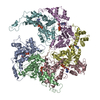

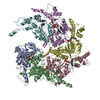

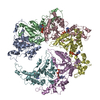

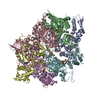
 PDBj
PDBj








